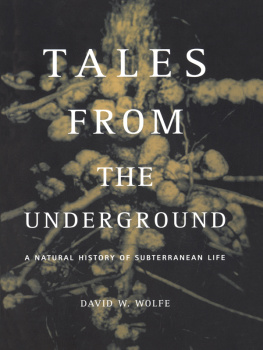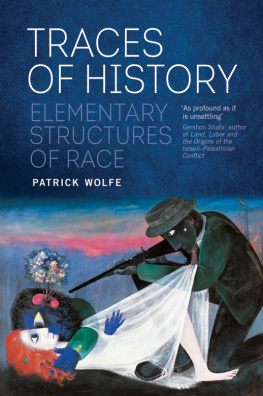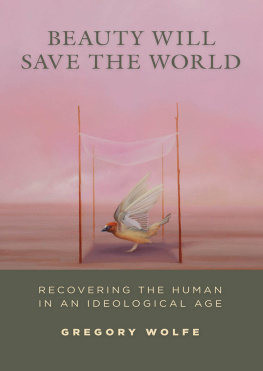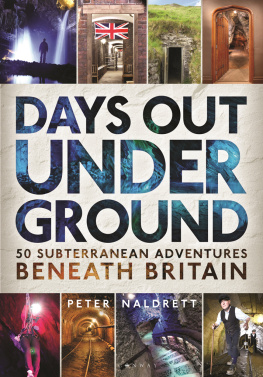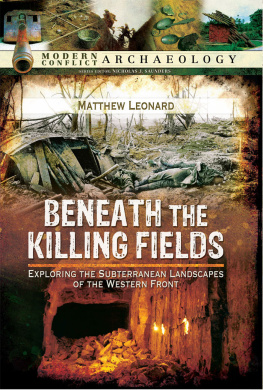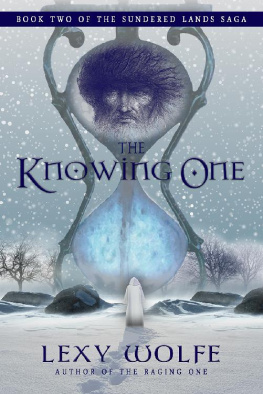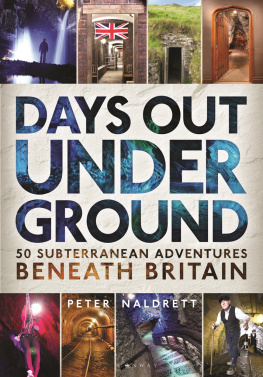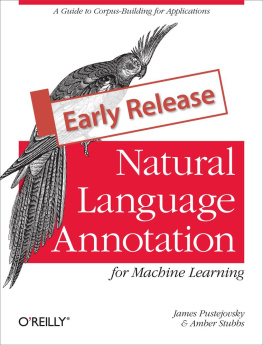Wolfe - Tales from the underground: a natural history of subterranean life
Here you can read online Wolfe - Tales from the underground: a natural history of subterranean life full text of the book (entire story) in english for free. Download pdf and epub, get meaning, cover and reviews about this ebook. City: Cambridge;Mass, year: 2002;2012, publisher: Basic Books;Perseus Pub, genre: Religion. Description of the work, (preface) as well as reviews are available. Best literature library LitArk.com created for fans of good reading and offers a wide selection of genres:
Romance novel
Science fiction
Adventure
Detective
Science
History
Home and family
Prose
Art
Politics
Computer
Non-fiction
Religion
Business
Children
Humor
Choose a favorite category and find really read worthwhile books. Enjoy immersion in the world of imagination, feel the emotions of the characters or learn something new for yourself, make an fascinating discovery.
Tales from the underground: a natural history of subterranean life: summary, description and annotation
We offer to read an annotation, description, summary or preface (depends on what the author of the book "Tales from the underground: a natural history of subterranean life" wrote himself). If you haven't found the necessary information about the book — write in the comments, we will try to find it.
Tales from the underground: a natural history of subterranean life — read online for free the complete book (whole text) full work
Below is the text of the book, divided by pages. System saving the place of the last page read, allows you to conveniently read the book "Tales from the underground: a natural history of subterranean life" online for free, without having to search again every time where you left off. Put a bookmark, and you can go to the page where you finished reading at any time.
Font size:
Interval:
Bookmark:


Many of the designations used by manufacturers and sellers to distinguish their products are claimed as trademarks.Where those designations appear in this book and Basic Books was aware of a trademark claim, the designations have been printed in initial capital letters.
Copyright 2001 by David W. Wolfe
Previously Published by Perseus Publishing
Published by Basic Books, A Member of the Perseus Books Group
All rights reserved. No part of this publication may be reproduced, stored in a retrieval system, or transmitted, in any form or by any means, electronic, mechanical, photocopying, recording, or otherwise, without the prior written permission of the publisher. Printed in the United States of America.
Library of Congress Control Number: 2002100783
ISBN 0-7382-0679-2
eBook ISBN: 9780786730933
Find us on the World Wide Web at http://www.basicbooks.com
Books published by Basic Books are available at special discounts for bulk purchases in the U.S. by corporations, institutions, and other organizations. For more information, please contact the Special Markets Department at the Perseus Books Group, 11 Cambridge Center, MA 02142, or call 617-252-5298 or e-mail special.markets@perseusbooks.com.
Text design by Jeffrey P. Williams
Set in 11-point Minion by the Perseus Books Group
First paperback printing, April 2002
TO MY FAMILY
I am pleased to have an opportunity to thank publicly the many friends, family members, and colleagues who have contributed to this book. I doubt that I would have had the stamina to complete this project without the unwavering and enthusiastic support of Terry Kristensen, who also carefully read through the earliest, sometimes long and tedious, drafts of each chapter and provided many comments that greatly improved the books tone and readability. I am very grateful to my editor, Amanda Cook, who believed early on that these tales were worth telling and who championed the project. In addition to providing many detailed suggestions that improved the prose, Amandas skillful guidance regarding the structure of individual chapters and the book as a whole was invaluable. I would also like to thank the others at Perseus Books who have contributed in various ways, and Tamara Clark for her wonderful illustrations.
This book is broad in scope, encompassing soil science, microbiology, biogeochemistry, ecology, human and plant pathology, animal behavior, genetics, and evolutionary biology. To tackle all of this, I called on many of my scientist colleagues for help, particularly Dean Biggins, Tom Eisner, Bill Ghiorse, Gary Harman, Bob Howarth, George Hudler, Ken Mudge, Aly Naguib, Janice Thies, Lynne Trulio, and Carl Woese. I thank them for being so very generous with their time, openly sharing their expertise and personal experiences, and reviewing portions of the manuscript. I was not able to incorporate all of their suggestions and had to make difficult decisions regarding what to leave in and what to leave out. The responsibility for any serious omissions or errors in the final product is completely mine.
I feel fortunate to work at an institutionCornell University that has a long history of encouraging faculty to communicate scientific information to the general public. I benefited from access to the outstanding collection of resources maintained at Cornells Mann Library and from the exceptional service of the dedicated staff who work there. Some of this book was written while on a sabbatical leave at the University of Nevada at Reno. I would like to thank Jeff Seemann of the Department of Biochemistry for providing me with a comfortable environment in which to work while I was there.
Special thanks to Diane Ackerman for some useful advice early on about writing and publishing. Thanks to Alan and Laura Falk for letting me use their lake house as a hideaway at a time when I most needed it. Finally, I thank all of my friends, my daughter, Alexis, and other family members for their cheerful understanding during long periods of neglect as I completed this ambitious project.
Man and mans earth are unexhausted
and undiscovered.
Wake and listen!
Verily, the earth shall yet be a source of recovery.
FRIEDRICH NIETZCHE (1911)
AND THUS SPAKE ZARATHUSTRA
O NE DOESNT HAVE TO VENTURE FAR INTO THE UNDERGROUND for new discoveries. Step out into the backyard, for example, push your thumb and index finger into the root zone of a patch of grass, and bring up a pinch of earth. You will likely be holding close to one billion individual living organisms, perhaps ten thousand distinct species of microbes, most of them not yet named, cataloged, or understood. Interwoven with the thousands of wispy root hairs of the grass would be coils of microscopic, gossamer-like threads of fungal hyphae, the total length of which would best be measured in miles, not inches. Thats in just a pinch of earth. In a handful of typical healthy soil there are more creatures than there are humans on the entire planet, and hundreds of miles of fungal threads.
Some zealous soil ecologists have recruited small armies of graduate students and marched them into forests and grasslands to compile a complete inventory of subterranean life. Within a dimension of one square yard (about one square meter), they typically uncover billions of microscopic roundworms called nematodes, anywhere from a dozen to several hundred of the much larger earthworms, and 100,000 to 500,000 insects and other arthropods (species with hard exoskeletons). And thats in addition to the astronomical numbers of fungi, single-celled bacteria and protozoa, and other creatures that dont fall into these major groups. Many of the arthropods are very tiny and can be spotted only with a magnifying lens. Some defy classification; they simply have never been seen before. Even in well-studied areas, new arthropods and other multicellular species of unknown function are routinely encountered.
The numbers are staggering, the biodiversity fascinating, and the potential for discovery unsurpassed by any other habitat on Earth. Yet we have spent more time and effort examining small patches on the surface of the moon and Mars than exploring the subterranean habitat of our own planet. The words of Leonardo da Vinci ring as true today as they did five hundred years ago: We know more about the movement of celestial bodies than about the soil underfoot. Even in modern laboratories, scientists are lucky if they can come up with the right nutrient mix to culture and study 1 percent of the microbes found in a typical soil sample. This poor success rate is due in part to the complex interdependence between subterranean organisms. They cant survive when isolated from their neighbors. Until very recently, we knew next to nothing about the 99 percent of soil microbes that we could not raise in captivity except what their rotting cellular remains looked like under a microscope.
NEW TOOLS, HOWEVER, have opened a window to the underground, ushering in a cornucopia of subterranean discovery. Many of these tools have been borrowed from the tool chests of molecular biologists. The same molecular techniques that allow modern crime labs to detect a fragment of the genetic material left by a suspect at a crime scene allow modern soil labs to probe for evidence of specific organisms or characterize the full range of microbial diversity in a pinch of soil or a rock sample from the deep Earth. This still leaves many questions unanswered, such as the function of the many genetic types found. However, by identifying similarities in the genetic codes of newly discovered organisms and those we are already familiar with, scientists are often able to determine the ecological role played by previously unknown genetic types. At this point, the scientific community is grateful simply to have an opportunity to begin to quantify and catalog all that we have been missing.
Font size:
Interval:
Bookmark:
Similar books «Tales from the underground: a natural history of subterranean life»
Look at similar books to Tales from the underground: a natural history of subterranean life. We have selected literature similar in name and meaning in the hope of providing readers with more options to find new, interesting, not yet read works.
Discussion, reviews of the book Tales from the underground: a natural history of subterranean life and just readers' own opinions. Leave your comments, write what you think about the work, its meaning or the main characters. Specify what exactly you liked and what you didn't like, and why you think so.

